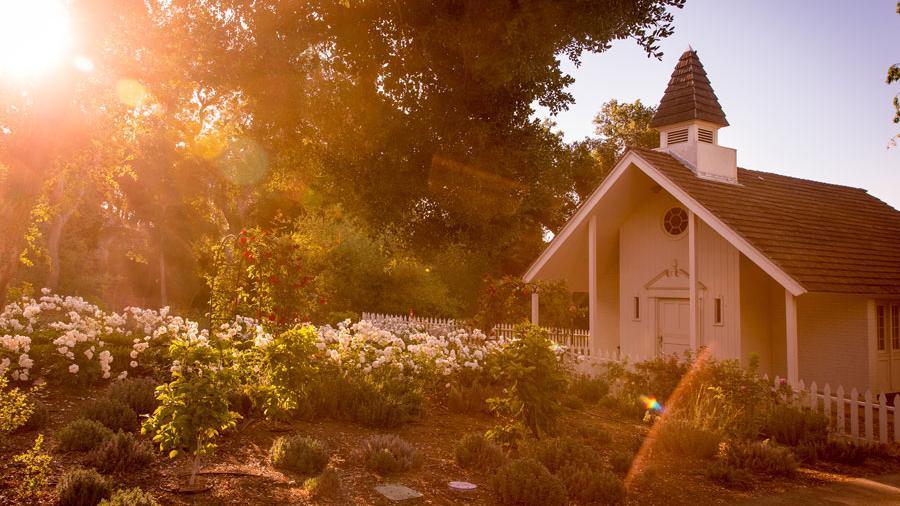Westmont Magazine A Window into Images of Jesus

In 1959, Nancy Voskuyl, a Westmont student and the daughter of President Roger Voskuyl and his wife, Trudy, died in a tragic automobile accident close to campus. To support the Voskuyl family and to remember Nancy, the college built the Nancy Voskuyl Memorial Prayer Chapel. Professor Ed Bouslough and his wife, Betty, close friends of the family, commissioned and donated a stained glass window of Jesus for the building.
In recent years, students noted that the window, the only representation of Jesus on campus, bears a particular weight. The rendering of him as white with his feet on North America became points of discussion. Does the image do what we need it to do now? After talking with students and the Voskuyl family, the college removed the stained-glass window in June 2020.
“We decided we would relocate the traditional image and replace it with a series of images that will broaden our understanding of the universal reach of Christ, thereby providing us with a powerful educational moment,” says President Gayle D. Beebe. “The Voskuyl family has been incredibly understanding and supportive.”
Professors Lisa DeBoer (art history) and Telford Work (theology) and Campus Pastor Scott Lisea have worked with President Beebe and others from diverse cultural backgrounds on this endeavor. Students, especially members of all six intercultural groups—Asian Students Association, Black Student Union, Latinx Student Union, Global and International Student Association, Multiethnic Student Association, and White Students for Racial Justice—are also involved.
Professor DeBoer notes that much has changed since 1961. “While Westmont remains rooted in and committed to the worldwide evangelical tradition, our student body is much more racially and ethnically diverse—and much more confessionally diverse,” she says. “The interior of the chapel itself has undergone changes with a recent renovation to provide more flexibility. All these changes have focused attention on the role of this specific image in the lives of students and in the symbolic articulation of our college’s mission and witness.”
Westmont has launched a project, Looking Back, Looking Forward: Images for Worship and Devotion, to choose new images better suited for a diverse evangelical college community. It will explore the origins of the original window in the wider history of Christian representation and generate new images reflecting greater ethnic and religious diversity. A final poster session will present the results of the study. “These activities will help engage and equip our entire student, staff and faculty community to appreciate more richly and approach more thoughtfully issues of race and representation, and issues of images and worship,” Professor DeBoer says.
To develop new images, four professors have hosted four Capax Dei groups of eight students, each studying a different book reflecting the following themes:
- Images of Christ throughout the history of the church and from around the world.
- How God’s church worships around the world.
- The seasons of the church year.
- The standard elements of Christian worship.
The groups will submit a variety of ideas for images in the chapel, and project leaders will select 12, one for each month.
The original window will move into the vestibule of the prayer chapel with a plaque explaining its role as a memorial. The vestibule contains other memorials as well, separating it from the devotional function of the sanctuary.
In a thoughtful essay, Professor Work reflects on what’s right and wrong about the original window. For example, he believes it’s good to make Jesus a focal point in keeping with the college’s motto, Christus primatum tenens (Christ holds first place).
“However, the window is dated, and it hasn’t aged well,” he says. “The image hasn’t lived up to the aspirations behind it, and that’s not right either. It reminds me of looking at old yearbook photos and cringing at the fashions and hairstyles. The window is more what Westmont was than who we are or want to be.”
Telford acknowledges that undoing the work of the artist, the donors and the Westmont community of 1961 seems unfair. Then he asks, “What about the racial context in which the window was produced? Isn’t that also a wrong that needed righting, and still does? Yes.”
How the college rights this wrong matters to Professor Work. “One of the common arguments is that the image subsumes Jesus into a white evangelicalism that is complicit in European colonialism and American racism,” he says. “That’s one way to interpret the window: as indelibly stained by its originators’ flaws. I can see how it pains viewers who associate the window with past and present wrongs in America and beyond. However, I don’t accept that it makes the window irredeemably invalid.”
Instead, Telford reflects on how God sets wrong things right. “Our whole faith testifies to a God who enters into the impossible situations we keep generating and uses unlikely events and messengers as vehicles of his salvation,” he says. “The Bible is full of irony; and in the end it’s a glorious irony, a treasure in earthen vessels. You and I are awkward, compromised, complicit earthen vessels too, so this isn’t just about a window, or even a society.
“So the situation is complicated. Some are attached to the window, some repelled; there are solid reasons for both reactions. I appreciate the way we’ve resisted zero-sum culture-war logic and cancel culture and focused on improving the chapel as a space better suited to learning, spiritual formation and glorifying God. Opening the space to student-crafted rotations of images is a lovely way for us to practice all three. The whole effort evokes the spirit of Romans 14-15 to reconcile diversity, foster hermeneutics of charity rather than suspicion and resentment, encourage us to look after one another even as we disagree, and honor the Lord who welcomes us all.”